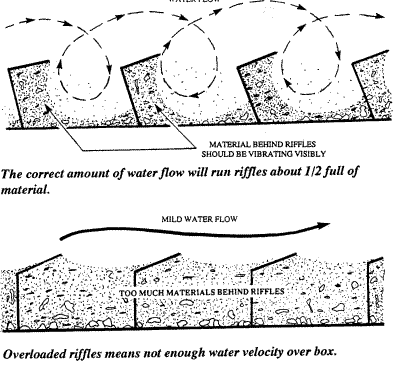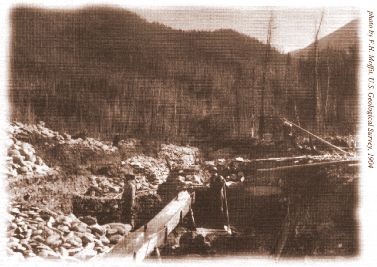The
sluice box is one of the most effective tools for recovering
placer gold and is at least half as old as mining
itself. A sluice box is "a sturdy rectangular box with
an open top and a bottom roughened by a set of riffles,
transversely mounted bars. Water and placer dirt are
introduced at the upper end of the inclined sluice box, and as
they flow  downward,
the specifically shaped riffles agitate the current preventing
lighter material from setting while retaining the heavier
valuable minerals" (Encyclopedia Britannica 2013). The
development of the sluice box most likely came from early
miners observations that gold could be found in much higher
concentrations in eddies and backwaters of the streams.
It was an attempt to copy this effect by constructing a
controlled channel for the water to run through with regularly
spaced stall points. The reason the
downward,
the specifically shaped riffles agitate the current preventing
lighter material from setting while retaining the heavier
valuable minerals" (Encyclopedia Britannica 2013). The
development of the sluice box most likely came from early
miners observations that gold could be found in much higher
concentrations in eddies and backwaters of the streams.
It was an attempt to copy this effect by constructing a
controlled channel for the water to run through with regularly
spaced stall points. The reason the sluice
box is so effective in recover gold, or any heavy mineral, is
because the specific gravity of gold is so high; gold has a
specific gravity of 19.3 compared to quartz, the main rock
forming mineral, which has a specific gravity of 2.65.
The large difference in density causes the gold particles to
fall out of suspension much faster and remain tucked under the
riffles while the lighter materials are washed away.
sluice
box is so effective in recover gold, or any heavy mineral, is
because the specific gravity of gold is so high; gold has a
specific gravity of 19.3 compared to quartz, the main rock
forming mineral, which has a specific gravity of 2.65.
The large difference in density causes the gold particles to
fall out of suspension much faster and remain tucked under the
riffles while the lighter materials are washed away.
 downward,
the specifically shaped riffles agitate the current preventing
lighter material from setting while retaining the heavier
valuable minerals" (Encyclopedia Britannica 2013). The
development of the sluice box most likely came from early
miners observations that gold could be found in much higher
concentrations in eddies and backwaters of the streams.
It was an attempt to copy this effect by constructing a
controlled channel for the water to run through with regularly
spaced stall points. The reason the
downward,
the specifically shaped riffles agitate the current preventing
lighter material from setting while retaining the heavier
valuable minerals" (Encyclopedia Britannica 2013). The
development of the sluice box most likely came from early
miners observations that gold could be found in much higher
concentrations in eddies and backwaters of the streams.
It was an attempt to copy this effect by constructing a
controlled channel for the water to run through with regularly
spaced stall points. The reason the sluice
box is so effective in recover gold, or any heavy mineral, is
because the specific gravity of gold is so high; gold has a
specific gravity of 19.3 compared to quartz, the main rock
forming mineral, which has a specific gravity of 2.65.
The large difference in density causes the gold particles to
fall out of suspension much faster and remain tucked under the
riffles while the lighter materials are washed away.
sluice
box is so effective in recover gold, or any heavy mineral, is
because the specific gravity of gold is so high; gold has a
specific gravity of 19.3 compared to quartz, the main rock
forming mineral, which has a specific gravity of 2.65.
The large difference in density causes the gold particles to
fall out of suspension much faster and remain tucked under the
riffles while the lighter materials are washed away. | http://www.alaskaoutdoorjournal.com/Activities/Goldpanning/kpgold3.html |